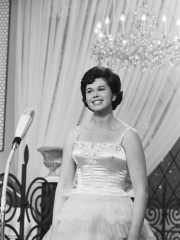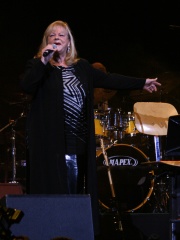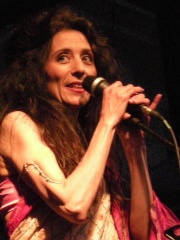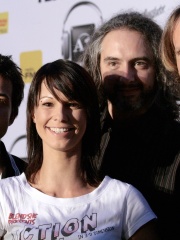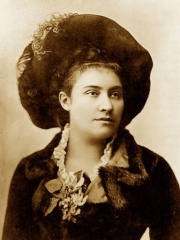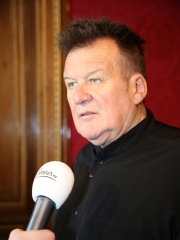
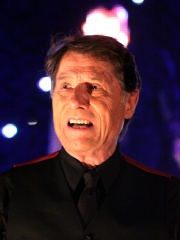
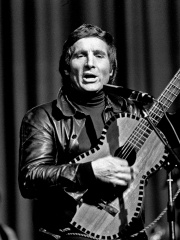

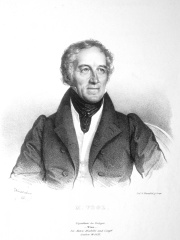

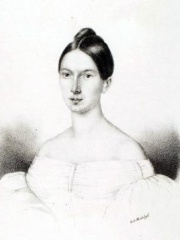

The Most Famous
SINGERS from Austria
Top 10
The following people are considered by Pantheon to be the top 10 most legendary Austrian Singers of all time. This list of famous Austrian Singers is sorted by HPI (Historical Popularity Index), a metric that aggregates information on a biography's online popularity. Visit the rankings page to view the entire list of Austrian Singers.

1. Falco (1957 - 1998)
With an HPI of 69.34, Falco is the most famous Austrian Singer. His biography has been translated into 46 different languages on wikipedia.
Johann "Hans" Hölzel (German: [ˈjoːhan hans ˈhœltsl̩]; 19 February 1957 – 6 February 1998), better known by his stage name Falco (from Falko Weißpflog), was an Austrian musician. He had several international hits, including "Der Kommissar" (1981), "Rock Me Amadeus", "Vienna Calling", "Jeanny", "The Sound of Musik", "Coming Home (Jeanny Part II, One Year Later)", and posthumously released "Out of the Dark". "Rock Me Amadeus" reached No. 1 on the Billboard charts in 1986, making Falco the only artist in history to score a number-one hit with a German language song in the United States. According to his estate, he has sold 20 million albums and 40 million singles, which makes him the best-selling Austrian singer of all time.

2. Udo Jürgens (1934 - 2014)
With an HPI of 67.79, Udo Jürgens is the 2nd most famous Austrian Singer. His biography has been translated into 54 different languages.
Jürgen Udo Bockelmann (30 September 1934 – 21 December 2014), generally known as Udo Jürgens, was an Austrian composer and singer of popular music whose career spanned over 50 years. He won the Eurovision Song Contest 1966 for Austria, composed close to 1,000 songs, and sold over 104 million records. In 2007, he additionally obtained Swiss citizenship. In 2010, he legally changed his name to Udo Jürgens Bockelmann. He is credited with broadening German-language pop music beyond the traditional post-war "schlager" (hit song) in the 1950s by infusing it with a modern pop appeal and French chanson style. His compositions and arrangements attracted fans of all ages, and he continued to fill venues in Germany, Austria, and Switzerland until his death at age 80.

3. Freddy Quinn (b. 1931)
With an HPI of 62.28, Freddy Quinn is the 3rd most famous Austrian Singer. His biography has been translated into 31 different languages.
Freddy Quinn (born Franz Eugen Helmut Manfred Nidl; 27 September 1931) is a former Austrian singer and actor whose popularity in the German-speaking world soared in the late 1950s and 1960s. As Hans Albers had done two generations before him, Quinn adopted the persona of the rootless wanderer who goes to sea but longs for a home, family and friends. Quinn's Irish family name comes from his Irish-born salesman father, Johann Quinn. His mother, Edith Henriette Nidl, was an Austrian journalist. He is often associated with the Schlager scene.

4. Conchita Wurst (b. 1988)
With an HPI of 61.68, Conchita Wurst is the 4th most famous Austrian Singer. His biography has been translated into 78 different languages.
Thomas "Tom" Neuwirth (born 6 November 1988) is an Austrian singer, media personality and drag queen who is known for his stage persona Conchita Wurst. He came to international attention after winning the Eurovision Song Contest 2014 for Austria with the song "Rise Like a Phoenix". Born in Gmunden, Neuwirth moved to Graz to do his Matura exam with a focus on fashion, before embarking on a singing career through the 2007 casting show Starmania. He subsequently became a founding member of Jetzt Anders!, a short-lived boy band. In 2011, Neuwirth began appearing as Conchita—a female character noted for her beard—and came second in the Austrian national final for the Eurovision Song Contest 2012. Two years later, Neuwirth was internally selected to represent Austria as Conchita at the Eurovision Song Contest 2014. His win brought him international attention and established him as a gay icon, resulting in invitations to perform at various pride parades, the European Parliament, and the United Nations Office in Vienna.
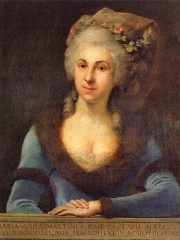
5. Marianna Martines (1744 - 1812)
With an HPI of 60.54, Marianna Martines is the 5th most famous Austrian Singer. Her biography has been translated into 17 different languages.
Marianna Martines, also Marianne von Martinez (4 May 1744 – 13 December 1812), was a composer, pianist, and singer of the Classical period, based in Vienna, Austria.

6. Johann Michael Vogl (1768 - 1840)
With an HPI of 57.86, Johann Michael Vogl is the 6th most famous Austrian Singer. His biography has been translated into 16 different languages.
Johann Michael Vogl (August 10, 1768 – November 19, 1840), was an Austrian baritone singer and composer. Though famous in his day, he is remembered mainly for his close professional relationship and friendship with composer Franz Schubert. Vogl was born in Steyr. As a young man he enrolled at the Gymnasium at Kremsmünster, where he studied languages, philosophy, and sang in several musical productions by his friend Franz Süßmayr (the same man who completed Mozart's Requiem). In 1786 Vogl went to Vienna to study, and later to practice law. In 1795 he debuted at the Vienna Hofoper, and quickly attracted a following for both his acting capability and the beauty of his voice. In 1813, Franz Schubert attended a performance of Gluck's Iphigénie en Tauride in which Vogl sang the role of Orestes; Schubert never forgot the experience and determined to write for Vogl. The following year, when Vogl sang the role of Pizarro at the premiere of the final version of Beethoven's Fidelio, it is said that the 17-year-old Schubert actually sold his schoolbooks in order to afford a ticket. When composer and singer finally met, in 1817, Vogl was as impressed with the quality of Schubert's music as Schubert was with Vogl's singing. Schubert wrote many of his subsequent songs with Vogl in mind. One of their early successes was an 1821 performance of Erlkönig, prior to its publication and to significant popular acclaim. Rarely in music history has the relationship of a composer and a specific singer been so musically productive. Vogl continued to sing Schubert's music after the death of his friend in 1828, famously singing a complete performance of Winterreise accompanied by the pianist Emanuel Mikschik shortly before his own death on the twelfth anniversary of the death of his friend. He died in Vienna.

7. Walter Berry (1929 - 2000)
With an HPI of 57.35, Walter Berry is the 7th most famous Austrian Singer. His biography has been translated into 16 different languages.
Walter Berry (8 April 1929 – 27 October 2000) was an Austrian lyric bass-baritone who enjoyed a prominent career in opera. He has been cited as one of several exemplary operatic bass-baritones of his era.

8. Caroline Unger (1803 - 1877)
With an HPI of 57.27, Caroline Unger is the 8th most famous Austrian Singer. Her biography has been translated into 16 different languages.
Caroline Unger (sometimes Ungher; 28 October 1803 – 23 March 1877), alternatively known as Karoline, Carolina, and Carlotta, was an Austro-Hungarian contralto.

9. Hansi Hinterseer (b. 1954)
With an HPI of 56.11, Hansi Hinterseer is the 9th most famous Austrian Singer. His biography has been translated into 17 different languages.
Johann Ernst "Hansi" Hinterseer (born 2 February 1954) is an Austrian schlager singer, actor, entertainer and former alpine skier.
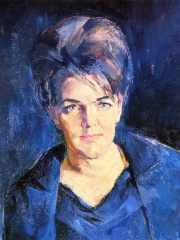
10. Leonie Rysanek (1926 - 1998)
With an HPI of 55.81, Leonie Rysanek is the 10th most famous Austrian Singer. Her biography has been translated into 15 different languages.
Leopoldine Rysanek (14 November 1926 – 7 March 1998), known professionally as Leonie Rysanek, was an Austrian dramatic soprano.
People
Pantheon has 40 people classified as Austrian singers born between 1744 and 2003. Of these 40, 29 (72.50%) of them are still alive today. The most famous living Austrian singers include Freddy Quinn, Conchita Wurst, and Hansi Hinterseer. The most famous deceased Austrian singers include Falco, Udo Jürgens, and Marianna Martines. As of April 2024, 5 new Austrian singers have been added to Pantheon including JJ, Anita, and Kaleen.
Living Austrian Singers
Go to all RankingsFreddy Quinn
1931 - Present
HPI: 62.28
Conchita Wurst
1988 - Present
HPI: 61.68
Hansi Hinterseer
1954 - Present
HPI: 56.11
JJ
2001 - Present
HPI: 54.57
Eleonore Schwarz
1936 - Present
HPI: 54.38
DJ Ötzi
1971 - Present
HPI: 52.25
Marianne Mendt
1945 - Present
HPI: 51.77
Anita
1960 - Present
HPI: 47.36
Timna Brauer
1961 - Present
HPI: 46.30
Alf Poier
1967 - Present
HPI: 46.29
Vincent Bueno
1985 - Present
HPI: 45.64
Christina Stürmer
1982 - Present
HPI: 44.38
Deceased Austrian Singers
Go to all RankingsFalco
1957 - 1998
HPI: 69.34
Udo Jürgens
1934 - 2014
HPI: 67.79
Marianna Martines
1744 - 1812
HPI: 60.54
Johann Michael Vogl
1768 - 1840
HPI: 57.86
Walter Berry
1929 - 2000
HPI: 57.35
Caroline Unger
1803 - 1877
HPI: 57.27
Leonie Rysanek
1926 - 1998
HPI: 55.81
Anna von Mildenburg
1872 - 1947
HPI: 55.53
Ferry Graf
1931 - 2017
HPI: 53.88
Amalie Materna
1844 - 1918
HPI: 52.56
Wilfried
1950 - 2017
HPI: 49.66
Overlapping Lives
Which Singers were alive at the same time? This visualization shows the lifespans of the 11 most globally memorable Singers since 1700.


